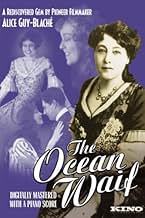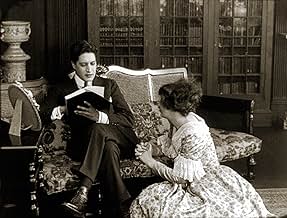Ajouter une intrigue dans votre langueAn abused woman finds love in the arms of a famous novelist.An abused woman finds love in the arms of a famous novelist.An abused woman finds love in the arms of a famous novelist.
Avis en vedette
Handsome young novelist Carlyle Blackwell (as Ronald Roberts) receives a message while yachting. His current novel is wildly successful and the publisher wants a follow-up. Meanwhile, on shore, pretty Doris Kenyon (as Millie) is beaten and pushed around by her alcoholic foster-father William Morris (as Hy Jessup). Having finally had enough, Ms. Kenyon runs away and moves into an abandoned mansion. There are rats living there, but Kenyon manages to stay out of their way. They are joined by Mr. Blackwell and his fussy valet Edgar Norton (as Hawkins). Blackwell needs a romantic and inspirational place to write his new book...
At first, Kenyon tries to stay hidden. The men wonder if she's the ghost talked about in the village. With Blackwell in the picture, you can count on romance. He is attracted to Kenyon, but his fiancée visits. There could even be a murder...
"The Ocean Waif" has deteriorated in spots, but can be enjoyed and understood. Directed by Alice Guy and produced by her husband Herbert Blache, the movie features nice Gothic house and fairly representative performances. The main draw, Carlyle Blackwell was a very big star. There is a limited level of restoration; due to severe damage, taking out every white spot would have been visually disarming. The film was certainly a longer feature, with at least 15 minutes missing. Apparently, a "bathing scene" featuring Kenyon is cut. Even more obvious, much of the ending is lost. A couple title cards, short clips and flashbacks successfully end the story.
**** The Ocean Waif (1916-11-02) Alice Guy ~ Carlyle Blackwell, Doris Kenyon, Edgar Norton, William Morse
At first, Kenyon tries to stay hidden. The men wonder if she's the ghost talked about in the village. With Blackwell in the picture, you can count on romance. He is attracted to Kenyon, but his fiancée visits. There could even be a murder...
"The Ocean Waif" has deteriorated in spots, but can be enjoyed and understood. Directed by Alice Guy and produced by her husband Herbert Blache, the movie features nice Gothic house and fairly representative performances. The main draw, Carlyle Blackwell was a very big star. There is a limited level of restoration; due to severe damage, taking out every white spot would have been visually disarming. The film was certainly a longer feature, with at least 15 minutes missing. Apparently, a "bathing scene" featuring Kenyon is cut. Even more obvious, much of the ending is lost. A couple title cards, short clips and flashbacks successfully end the story.
**** The Ocean Waif (1916-11-02) Alice Guy ~ Carlyle Blackwell, Doris Kenyon, Edgar Norton, William Morse
"The Ocean Waif" is a run-of-the-mill production for 1916, with a simplistic romance that turns melodramatic at the bookends with an abusive stepfather. The treatment is mostly light in the middle. One especially funny moment, intentional or not, comes after the writer finds his muse in the runaway ocean waif; he claims to have written his best story and then reads this line from it: "The girl was as beautiful as a rose." At least, the leads, Carlyle Blackwell and Doris Kenyon, were attractive.
The film was directed by Alice Guy, who was the world's first female filmmaker, beginning with Gaumont in France back in 1896. It's impressive enough that she managed to remain in the business for twenty-some years during a period of the most rapid development; she outlasted Edwin S. Porter, Georges Méliès and many other of her contemporaries. If not much else, "The Ocean Waif" demonstrates that she, or at least her assistants, adopted new techniques and practices, such as quick scene dissection, closer camera perspectives and star treatment, which is what men like Porter and Méliès failed to do by the 1910s. The film isn't particularly good in any of these respects, but it's at least not outdated for 1916. I was confused, however, by the use of an oval frame masking in the opening sequences; the effect didn't appear to have a function.
More interesting than the film proper is the preservation, restoration and presentation of its, reportedly, sole surviving print. The film apparently lacks some footage, and there's considerable deterioration, but when there's not, it's a beautiful, antique fine-grain 35mm print transfer under the typical scratches and mottling. I'm, perhaps, even more impressed and thankful that one of the leaders in distributing silents to home video would risk its reputation by presenting such an aged film. I commend Kino for that. I hope they and others continue to release rare films that lack pristine prints, because most silents that survive, which is not most of them, do not exist in the great condition of some of the more popular home video presentations.
The film was directed by Alice Guy, who was the world's first female filmmaker, beginning with Gaumont in France back in 1896. It's impressive enough that she managed to remain in the business for twenty-some years during a period of the most rapid development; she outlasted Edwin S. Porter, Georges Méliès and many other of her contemporaries. If not much else, "The Ocean Waif" demonstrates that she, or at least her assistants, adopted new techniques and practices, such as quick scene dissection, closer camera perspectives and star treatment, which is what men like Porter and Méliès failed to do by the 1910s. The film isn't particularly good in any of these respects, but it's at least not outdated for 1916. I was confused, however, by the use of an oval frame masking in the opening sequences; the effect didn't appear to have a function.
More interesting than the film proper is the preservation, restoration and presentation of its, reportedly, sole surviving print. The film apparently lacks some footage, and there's considerable deterioration, but when there's not, it's a beautiful, antique fine-grain 35mm print transfer under the typical scratches and mottling. I'm, perhaps, even more impressed and thankful that one of the leaders in distributing silents to home video would risk its reputation by presenting such an aged film. I commend Kino for that. I hope they and others continue to release rare films that lack pristine prints, because most silents that survive, which is not most of them, do not exist in the great condition of some of the more popular home video presentations.
I just saw this film as part of TCM's Women Pioneer Filmmakers Series. What a fascinating woman Alice Guy Blache was! And what a shame (although that isn't a strong enough word) that her legacy is not well-known to the public. This film is quite enchanting--parts of it reminded me of "Broken Blossoms" (1919). But while it has elements of tragedy, and even a dark streak of incest courtesy of the foster father, there are tender and light-hearted moments of comedy that keep it from bogging into too much sentiment. Guy's motto was "Be Natural", and it's amazing how well the actors in her company took this to heart--there is very little of the histrionic style of acting in this film, which makes it so much easier for a modern audience to watch.
Alice Guy Blache's films should be revived, they should be available on VHS and DVD, and her legacy needs to be recognized!
Alice Guy Blache's films should be revived, they should be available on VHS and DVD, and her legacy needs to be recognized!
The Ocean Waif (1916)
** 1/2 (out of 4)
Silent melodrama about author Ronald Roberts (Carlyle Blackwell) who gets word that his latest book is a huge seller so he's asked to write another. He winds up in a small location to write but he ends up getting involved with a young woman named Millie (Doris Kenyon) who is trying to get away from her abusive father.
Alice Guy directed this film, which has enough good moments to make it worth viewing, although there's no doubt that it's still far from being a classic or even a good movie for that matter. I think the main reason to watch it is for the performances that are actually pretty good. Blackwell certainly makes you believe his character but it's Kenyon who steals the picture. I thought she was very good no matter what type of emotion her character was playing and I especially liked the chemistry of the two actors.
The film features some nice cinematography and there's no doubt that Guy has a good way to build up the relationship. With that said, even for 1916 standards the story itself really isn't anything we hadn't already seen and there's no question that it's quite predictable. Fans of silents will want to check it out.
** 1/2 (out of 4)
Silent melodrama about author Ronald Roberts (Carlyle Blackwell) who gets word that his latest book is a huge seller so he's asked to write another. He winds up in a small location to write but he ends up getting involved with a young woman named Millie (Doris Kenyon) who is trying to get away from her abusive father.
Alice Guy directed this film, which has enough good moments to make it worth viewing, although there's no doubt that it's still far from being a classic or even a good movie for that matter. I think the main reason to watch it is for the performances that are actually pretty good. Blackwell certainly makes you believe his character but it's Kenyon who steals the picture. I thought she was very good no matter what type of emotion her character was playing and I especially liked the chemistry of the two actors.
The film features some nice cinematography and there's no doubt that Guy has a good way to build up the relationship. With that said, even for 1916 standards the story itself really isn't anything we hadn't already seen and there's no question that it's quite predictable. Fans of silents will want to check it out.
You may have to calibrate expectations to just how early a film this is, as it shows signs of wear, some cheesy acting (Eek! A mouse! Oh no! A ghost!), and only 41 minutes of it have survived. On the other hand, pioneering director Alice Guy-Blaché tells a complete story and captures some endearing shots. The casting of 19-year-old Doris Kenyon was wise; she has such a wonderful, almost modern screen presence and a big, natural smile. The fragmented scene with her milking a cow really shows this off. She's also engaging when she dusts off an old mirror to peer into her reflection, and when she's out in a field gathering flowers with the leading man (Carlyle Blackwell). The film is not all lightness though, and there are cringe-worthy moments with her abusive foster father (William Morris), who tries to rape her. It's too bad the entire print doesn't survive, but what does is easily worth the quick watch.
Le saviez-vous
- AnecdotesA surviving copy is held at the Library of Congress.
- Citations
Ronald Roberts: She is only an ocean waif whom I am protecting.
Ruth Hart: Is kissing part of the protection?
- Autres versionsKino International copyrighted and released a video in 2000, which was restored from the Library of Congress Motion Picture Conservation Center preservation print. It was produced by Jessica Rosner, has a piano score composed and performed by Jon Mirsalis and runs 40 minutes.
- ConnexionsFeatured in Le jardin oublié: La vie et l'oeuvre d'Alice Guy-Blaché (1996)
Meilleurs choix
Connectez-vous pour évaluer et surveiller les recommandations personnalisées
Détails
- Durée40 minutes
- Mixage
- Rapport de forme
- 1.33 : 1
Contribuer à cette page
Suggérer une modification ou ajouter du contenu manquant

Lacune principale
By what name was The Ocean Waif (1916) officially released in Canada in English?
Répondre






















